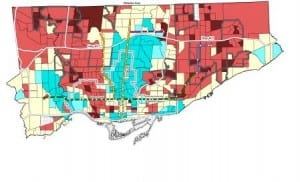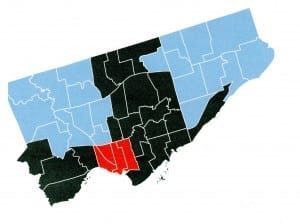David Hulchanski’s “Three Cities Within Toronto” map closely matches the Oct. 27, 2014 ward by ward mayoral election results
David Hulchanski’s “Three Cities” map can be accessed here.
An Oct. 27, 2014 CBC article that features a ward by ward map of the Oct. 27, 2014 mayoral electoral results can be accessed here.
Updates, including Oct. 29, 2014 article by David Hulchanski
An Oct. 29, 2014 Spacing article by David Hulchanski is entitled: “Toronto’s mayoral election in four maps.”
A Nov. 6, 2014 Globe and Mail editorial is entitled: “Ending mandatory long-form census has hurt Canada.”
A Nov. 11, 2014 CBC article is entitled: “Muzzling federal scientists may be damaging to government itself.”
A Dec. 7, 2014 Toronto Star article is entitled: “Toronto is divided, but not as badly as other major cities.” The subhead reads: “All North American cities are splintering, but the causes relate to a broader economy that municipal governments have little power to change.”
A Dec. 8, 2014 Toronto Star article is entitled: “A tale of income inequality in five Toronto neighbourhoods: We use U of T professor David Hulchanski’s research to take a close look at changes in recent decades in five Toronto neighbourhoods.”
A Jan. 16, 2015 Toronto Star article is entitled: “Mapping our political divides: A team of political scientists has mapped out Toronto’s ideological landscape by ward, identifying where the city’s political left and right reside.”
[End of updates]

The map is from David Hulchanski’s “Three Cities Within Toronto” document, accessible from a link at the blog post you are now reading.

Ward by ward map of Oct. 27, 2014 mayoral results. Dark blue: Tory. Light blue: Ford. Orange: Chow. Source; Oct. 27, 2014 CBC online election results. See link at the blog post you are now reading.
Oct. 28, 2014 panel at CBC The Current
An Oct. 28, 2014 CBC The Current discussion involving three panelists on Oct. 28, 2014 offers an overview of the dynamics that are at play, in the creation of the results portrayed in the map of the Oct. 27, 2014 mayoral election results.
Among the points made in the discussion (this is my summary):
- One group of voters has been empowered in angry, negative ways. The populist politicians who have targeted that group of voters has made “fudging the truth very mainstream.”
Another way to say this is that the eradication of evidence, and the celebration of truthiness, can be strongly appealing under specified circumstances.
A well-crafted slogan, that is not based upon evidence, can pack a tremendous emotional wallop. Knowledge is power, and that the absence of knowledge can be leveraged in powerful ways.
Peter Mendelsund (2014: 31) comments: “Characters are ciphers. And narratives are made richer by omission.”
A relevant Oct. 29, 2014 CBC The Current podcast is entitled: “Author Michael Harris argues Stephen Harper is ‘profoundly anti-democratic.'”
Decisions made in the absence of evidence may not be good decisions. In the long run, such decisions may lead to chaos and destruction.
Hulchanski’s research and the eradication of evidence
An Oct. 7, 2014 Toronto Star article is entitled: “Eye-opening research stopped in its tracks.”
The subhead reads: “University of Toronto researcher David Hulchanski recounts how Ottawa destroyed his mapping device for urban poverty.”
Environics Analytics’ 2014 demographic estimates
An Oct. 23, 2014 Toronto Star article is entitled: “Where Toronto mayoral candidates live affects policies, values, experts say.”
The subhead reads: “The neighbourhoods mayoral candidates live in and who their neighbours are affects who votes for them, their policies and outlooks to varying degrees, say political experts.”
The article draws from Environics Analytics’ 2014 demographic estimates.
Oct. 28, 2014 Metro Toronto newspaper overview of electoral results
An Oct. 28, 2014 Metro Toronto article is entitled: “It was a predictable election, now let’s change the tone on ‘Ford Nation.'”
An excerpt reads:
- If you want to talk about why Ford Nation is still a thing, you have to talk about poverty. You have to talk about how Toronto has allowed parts of the city with the best transit and the most jobs to become wildly unaffordable for pretty much anyone who didn’t win the privilege lottery. You also have to talk about how there are some politicians who don’t really care about any of this, because the people most affected by the city’s inequality don’t vote anyway.
- Just like the election results themselves, the city’s next four years feel predictable. Tory will be a steady presence in the mayor’s office, focusing on business issues and the economy. As an incumbent, he’ll have a virtual lock on re-election, provided he doesn’t antagonize the city’s progressive voters.
- Meanwhile, Ford Nation, such as it is, will continue to exist on the periphery. They’ll be loud, passionate, alienated and politically inconsequential. Throughout it all, our politicians will continue to talk about the need to be a more united city. But unless the new mayor and council aren’t as predictable as they look, it’ll never really get past the talk stage.
[End of excerpt]
Comment
Let us put it another way. Sense-making tends to include a dramaturgical element. Communications tend to involve some element of performance, of theatre. They also tend to feature the application of instrumental reason, which can be used for any end, good or evil.
Effective communication, whichever of the “Three Cities within Toronto” one happens to live in, possesses a dramaturgical element. Honest statements of facts, as well as scams and scamming, in a figurative or literal sense, can be found in each of the “Three Cities.”
Simple, well-crafted soundbites or narratives, based upon facts or in the absence of them, are capable of having a strong, and strongly motivating, emotional impact. The outcome, at any given moment, can be constructive or destructive, depending upon the circumstances and one’s point of view.
Updates: Where does inequality flourish the most?
An Oct. 22, 2014 Torontoist article is entitled: “Immigration and Visible Minority Status Shape Toronto Election Turnout, Study Finds: Candidates often don’t reflect the diversity of their constituencies — and that may be keeping some residents away from the ballot box.”
A Nov. 5, 2014 Global Toronto article is entitled: “Ford Nation 2014: 14 things demographics tell us about Toronto voters.”
A Nov. 6, 2014 Globe and Mail article is entitled: “How Toronto, Vancouver and Montreal became cities split by class.”
The topics at this post are further addressed at a subsequent post:
A March/April 2014 Mother Jones article is entitled: “What If Everything You Knew About Poverty Was Wrong?”
The following post adds background to the discussion:
Voter anger explained – in one chart – March 15, 2016 Brookings Institution article

Leave a Reply
Want to join the discussion?Feel free to contribute!